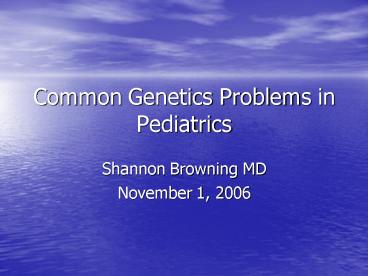Common Genetics Problems in Pediatrics - PowerPoint PPT Presentation
1 / 16
Title:
Common Genetics Problems in Pediatrics
Description:
Klinefelter Syndrome ... Down's Syndrome. 95% of all those affected with DS have trisomy of the chromosome 21 ... Turner Syndrome ... – PowerPoint PPT presentation
Number of Views:758
Avg rating:3.0/5.0
Title: Common Genetics Problems in Pediatrics
1
Common Genetics Problems in Pediatrics
- Shannon Browning MD
- November 1, 2006
2
Klinefelter Syndrome
- Occurs in approximately 1 in 1000 births
- 80 have the classic 47,xxy karyotype, with 10
having 46,XY/47XXY mosaicism and another 10
having multiple x or Y chromosomes - Results from nondisjunction and is often
associated with advanced maternal age - Rarely diagnosed before the onset of puberty
3
Klinefelter Syndrome
- Most children with KS present initially with
behavior problems , abnormal puberty or
infertility issues - Typically taller than average and increased
carrying angle and a relatively wide pelvis - 30 will develop gynecomastia during in puberty
4
Klinefelter Syndrome
- 50 of children have speech delays and 25 have
motor - All affected males are infertile, although there
are rare cases of fertility
5
Sickle Cell Disease
- Results from a single genetic mutation in which a
nucleotide in the coding sequence of a
beta-globin gene is mutated from adenosine to
thymidine - This mutation occurs in the middle of the triplet
that codes for normally glutamic acid as the 6th
AA of the beta-chain of hemoglobin. The single
base change substitutes Valine for glutamic acid.
6
Sickle Cell Disease
- The resulting mutated hemoglobin has decreased
solubility and abnormal polymerization properties - If only 1 beta-globin gene is mutated
heterozygous state which is referred to as sickle
cell trait - If both genes are mutated resulting in homozygous
state and called sickle cell anemia or sickle
cell disease.
7
Sickle Cell Disease
- Prenatal testing for sickle cell has improved
significantly over the past 2 decades. - The newborn with sickle cell disease is not
anemic initially because of the protective
affects of elevated fetal hemoglobin. Hemolytic
anemia develops over the 1st 2-4mo. - Chorionic villus sampling can be performed as
early as 9 wks gestation making it an earlier
alternative to amniocentesis.
8
Teratogens
- Accutane embryopathy is associated with embryonic
exposure to isotretinoin beyond the 15th day
after conception and through the end of 1st
trimester - Isotretinoin is a vitamin A derivative that is
administered orally and used for the treatment of
cystic acne - It impedes the normal neural crest migration in
the developing embryo.
9
Teratogens
- This disruption in the migration of the neural
crest cells leads to defects in the central
nervous system, severe ear anomalies, conotruncal
heart defects and thymic abnormalities - Alcohol can cause all the above mentioned
abnormalities with the exception of thymus
abnormalities
10
Teratogens
- Warfarin embryopathy is a recognizable pattern of
malformation. Warfarin acts as an anticoagulant
because it is a vitamin K antagonist. It
prevents the carboxylation of gamma-carboxyglutami
c acid which is a component of osteocalcin and
other vit K dependent bone proteins. - The critical period of exposure is between 6-9
weeks.
11
Downs Syndrome
- 95 of all those affected with DS have trisomy of
the chromosome 21 - 90-95 of these cases are due to maternal meiotic
error with 75 occurring in meiosis I. 3-5 are
due to paternal meiotic errors and the remainder
are due to mitotic nondisjunction - Recurrence risk estimates are based on empiric
data - The overall recurrence risk for having a child
with any trisomy is approx 1 added to the
mothers age-related risk. As a woman ages the
age related risk exceeds the recurrence risk
12
CHARGE association
- Ccoloboma, Hheart defect, Aatresia choanae, R
retardation of growth postnatally and
development, Ggenital anomalies, and Eear
anomalies - Affected individuals must have 4 of the 6
features with at least one being coloboma or
atresia choanae - There are multiple causes of this association
13
Turner Syndrome
- The two most common features in girls with TS is
short stature and gonadal dysgenesis. It should
be suspected in any girl of short stature with
unknown cause. - Estimated that 1 in 2500 girls are affected
- Linear growth velocity varies from birth to 3
yrs it is normal, from 3-12 yrs velocity
decreases, and after age 12 it decelerates even
further. - Most affected girls have a 45,X karyotype
- Diagnosis is based on chromosomal analysis
14
Neurofibromatosis Type I
- Occurs in 1 in 3000 to 1 in 4000 lives births and
is unrelated to gender, ethnicity or geographic
location - Autosomal dominant condition
- 50 of cases are spontaneous mutations in the
gene that codes for neurofibromin on chromosome
17. - Males and females are equally affected
- The recurrence risk to offspring of an affected
individual is 50 - This gene abnormality shows full penetrance
15
Neurofibromatosis Type I
- Café au lait macules (CALMs) are uniformly
pigmented flat spots that range in size from a
few mm to as much as 30cm in adults. CALMs
increase in size in proportion to growth. - One or two CALMs are common more than 6 raises
the concern about NF-1 - Of children who present with 6 or more CALMs 89
meet the diagnostic criteria for NF-1 within 3
years.
16
Angelman Syndrome
- Affected children are normal at birth
- They experience global developmental delay, but
speech is affected most. Most children will
never speak - They laugh frequently and have an ataxic gait and
often hold their elbows away from their bodies.

